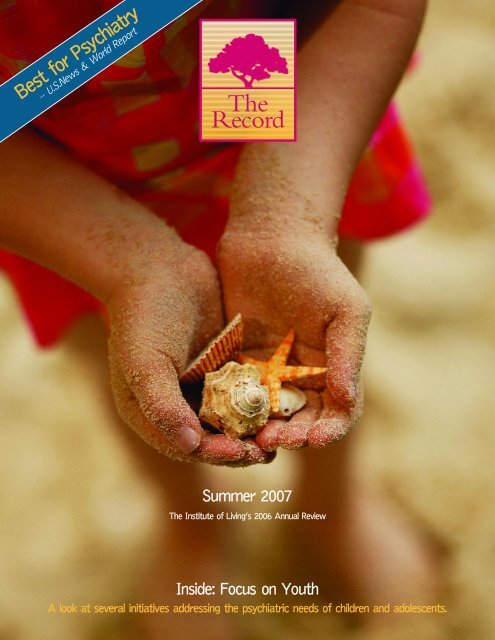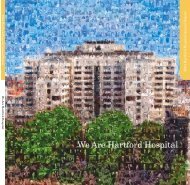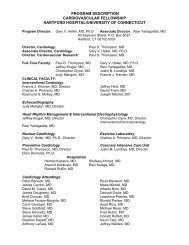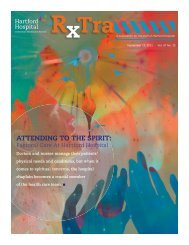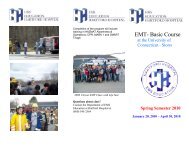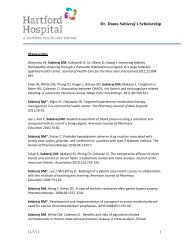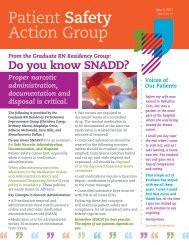The Record, Summer 2007 - Hartford Hospital!
The Record, Summer 2007 - Hartford Hospital!
The Record, Summer 2007 - Hartford Hospital!
Create successful ePaper yourself
Turn your PDF publications into a flip-book with our unique Google optimized e-Paper software.
Best for Psychiatry<br />
– U.S.News & World Report<br />
<strong>The</strong><br />
<strong>Record</strong><br />
<strong>Summer</strong> <strong>2007</strong><br />
<strong>The</strong> Institute of Living’s 2006 Annual Review<br />
Inside: Focus on Youth<br />
A look at several initiatives addressing the psychiatric needs of children and adolescents.<br />
3
ontents<br />
1<br />
On and Off Campus<br />
News and notes of interest<br />
2<br />
BrainDance<br />
Makes Strides<br />
In just a few short years, this<br />
innovative program has gone<br />
from concept to captivating.<br />
6<br />
Focus on Youth<br />
New initiatives aim to better<br />
understand and treat mental<br />
health disorders in children<br />
and adolescents.<br />
10<br />
Returning to the Roots<br />
of Moral Treatment<br />
A visit to a storied English<br />
institution prompts dialogue<br />
on the state of American<br />
mental health care.<br />
11<br />
<strong>The</strong> Year in Review<br />
Leadership perspectives on<br />
the year past, and what’s to<br />
come.<br />
12<br />
Honoring Colleagues<br />
First Class Graduates<br />
After 10 years as a joint program with UConn, the Institute’s own four-year<br />
Adult Psychiatry Residency Program was re-established in 2002, with the first<br />
residents arriving in July 2003. This spring, the program reached a milestone<br />
with the graduation of the first class. Graduation ceremonies for the five<br />
newly minted psychiatrists were held at the Pond House in West <strong>Hartford</strong> on<br />
June 14. <strong>The</strong> sixth member of the first class is a resident in the five-year Child<br />
& Adolescent Residency Program.<br />
Adrienne Bentman, MD, director of residency training, says that the first<br />
class played a unique role in helping to shape the re-established program.<br />
“<strong>The</strong>y were part of a customary process in which a medical student is<br />
transformed into an independent, autonomously functioning, deliberative,<br />
engaged psychiatrist,” Dr. Bentman says. “But they were also pioneers. <strong>The</strong>y<br />
worked closely with me and key faculty to establish the ethos and norms of<br />
the program. <strong>The</strong>y have left their mark, and I could not have done it without<br />
them.”<br />
<strong>The</strong> program has attracted exceptionally qualified candidates from the<br />
start. Dr. Bentman describes members of the first class as “remarkable in their<br />
energy, intelligence, engagement, work ethic, humility, humanity and compassion,”<br />
who will be excellent practicing psychiatrists.<br />
Keeping Olmsted’s Vision Alive<br />
<strong>The</strong> Institute’s gracious grounds, complete with a number of exceptional trees, were designed in 1861 by renowned<br />
landscape architect Frederick Law Olmsted. Olmsted, who also designed the grounds of many of the country’s<br />
most famous spaces, is today recognized as the founder of landscape architecture in America.<br />
To help ensure that Olmsted’s vision for the IOL campus is preserved for future generations, the Institute has<br />
engaged a professional landscape architect. Norma Williams, of Ridgefield, holds a master’s degree in landscape<br />
architecture from the University of Virginia with a concentration in historic preservation. She is currently preparing<br />
a report describing how the IOL’s landscape has evolved and recommending steps to keep the trees thriving.<br />
She is doing historical research on the grounds, using information from sources including the IOL’s “Myths, Minds<br />
and Medicine” exhibit and the <strong>Hartford</strong> <strong>Hospital</strong> archives.<br />
Ms. Williams points out that Olmsted believed strongly in the power of natural surroundings to promote both<br />
physical and mental health, and she plans to investigate that connection. She is working with an arborist to develop<br />
recommendations for some of the notable trees on campus, and she will be considering changes in landscape<br />
features, such as benches or new shrub and perennial plantings, that could enhance the grounds.<br />
“I hope that one result of this work will be a maintenance plan for the proper long-term care of the trees and<br />
suggestions for new plantings,” says Ms. Williams.<br />
A salute to people who make<br />
a difference every day.<br />
Background: Olmsted’s original plan for the Institute’s grounds.
on and off campus<br />
<strong>Hartford</strong> <strong>Hospital</strong> Named One of Nation’s Best for Psychiatry<br />
<strong>Hartford</strong> <strong>Hospital</strong> has been rated one of the country’s top hospitals for psychiatry services in this year’s<br />
U.S.News & World Report's “Best <strong>Hospital</strong>s” rankings for <strong>2007</strong>. This marks the first<br />
time that a <strong>Hartford</strong> <strong>Hospital</strong> specialty area has made the list. A number<br />
of factors contribute to this achievement. <strong>The</strong>se include the explosive<br />
growth of our outstanding research programs, with their attendant<br />
publications and national and international presentations, and the growing<br />
presence of our outstanding residency and postdoctoral training programs.<br />
<strong>The</strong> support that psychiatry programs have received from <strong>Hartford</strong><br />
<strong>Hospital</strong>'s administration and Board and from the IOL Board has also<br />
been important. But the foundation for this recognition is clearly our reputation<br />
for outstanding clinical<br />
care. And so, I want to thank and congratulate our<br />
faculty, researchers, clinical and nonclinical staff, administrators<br />
and every single individual working here as part<br />
of <strong>Hartford</strong> <strong>Hospital</strong>'s Institute of Living. This recognition<br />
is for you. Thank you for all you do!<br />
– Hank Schwartz, Psychiatrist-in-Chief<br />
People and Positions<br />
Karen Bullock, LCSW, PhD, has been named to the newly created<br />
position of director of social work training and staff development. In<br />
this role, she will oversee the social work internship program and<br />
develop ongoing training for social work staff. Dr. Bullock also was<br />
recently named <strong>2007</strong> Educator of the Year by the Connecticut<br />
Chapter of the National Association of Social Workers.<br />
Kikke Levin-Gerdner, MEd, has been named director of the<br />
Institute’s Webb Schools. She succeeds Surrey Hardcastle, who is<br />
retiring after 29 years with the schools. Ms. Levin-Gerdner, who has<br />
been a teacher and administrator at the Grace S. Webb School for<br />
more than a decade, was selected following a national search.<br />
Burlingame Award Given to <strong>Hartford</strong> Native<br />
Jerrold F. Rosenbaum, MD, has been named the recipient of the Institute of<br />
Living’s <strong>2007</strong> C. Charles Burlingame, MD, Award. A native of <strong>Hartford</strong><br />
who grew up in West <strong>Hartford</strong>, Dr. Rosenbaum is now<br />
Stanley Cobb professor of psychiatry at Harvard<br />
Medical School and executive director of the<br />
Massachusetts General <strong>Hospital</strong> Mood and Anxiety<br />
Disorders Institute.<br />
Dr. Rosenbaum is recognized internationally as a<br />
leader in researching and treating mood and anxiety<br />
disorders, with an emphasis on pharmacotherapy. He<br />
has also developed innovative educational programs<br />
and mentored several of the world’s leading experts in<br />
psychopharmacology.<br />
<strong>The</strong> prestigious Burlingame Award, presented annually<br />
since 1998, recognizes outstanding leadership and<br />
lifetime achievement in psychiatric research and education.<br />
Dr. Rosenbaum will accept his award at a special ceremony in the fall.<br />
1
Jim Seltzer, PhD, left, and<br />
Godfrey Pearlson, MD, with a<br />
scene from Stigma, a video documentary<br />
that was the Overall<br />
Winner of the <strong>2007</strong> BrainDance<br />
competition. Alexander Yan and<br />
Pedro Ondrush, students at<br />
Waterbury’s Kennedy High<br />
School, created the video.<br />
2
BrainDance<br />
Makes Strides<br />
An IOL program aimed at reducing the stigma of<br />
mental illness has expanded dramatically in a short<br />
time, capturing the interest and imagination of students<br />
and teachers statewide.<br />
Every illness presents challenges to<br />
patients and their families. But, for people<br />
with mental illness, the stigma too<br />
often associated with their diseases represents<br />
an extra burden.<br />
“Society’s misconceptions about mental illness result in a<br />
stigma that is a huge problem for patients and families,” says Jim<br />
Seltzer, PhD, senior consultant for schizophrenia services at the<br />
Institute of Living. “Stigma has a significant negative impact on<br />
treatment outcomes. It makes people less likely to come in for<br />
treatment and continue treatment, less able to get jobs, and less<br />
able to return to their communities and their lives.”<br />
<strong>The</strong>se are some of the reasons why, in 2004, Dr. Seltzer<br />
and Godfrey Pearlson, MD, director of the IOL’s Olin Neuropsychiatry<br />
Research Center, conceived the idea for the<br />
BrainDance Awards. <strong>The</strong> innovative program was designed to<br />
educate people about mental illness and, in doing so, remove<br />
the mystery, misconceptions and stigma frequently associated<br />
with psychiatric diseases.<br />
<strong>The</strong> annual BrainDance Awards program offers cash prizes<br />
to Connecticut high school and college students who submit<br />
creative or scientific projects exploring some aspect of mental<br />
illness. <strong>The</strong> goal is to encourage students to gain knowledge<br />
about psychiatric diseases and develop a more tolerant and<br />
realistic perspective toward people with severe psychiatric<br />
problems. Other goals of BrainDance are to promote students’<br />
interest in careers in mental health and acquaint them with<br />
some of the recent neuroscience discoveries about the brain.<br />
<strong>The</strong> response from students and educators has been tremendous.<br />
In 2004, its first year, BrainDance received 40 entries—a<br />
healthy number for a fledgling program. But in <strong>2007</strong>, the number<br />
of entries grew to nearly 200. And quantity wasn’t the only<br />
difference.<br />
“<strong>The</strong> quality and character of entries has changed over the<br />
years,” says Dr. Seltzer. “We’ve always had a certain number of<br />
students who have submitted excellent projects. But this year, a<br />
great many of the entries were absolutely superb. It was clear<br />
that the students became very invested in their projects.”<br />
3
Clockwise from top left: Brittany Speisman of Wesleyan University, who won the BrainDance first place prize for a college science project, is congratulated<br />
by James Seltzer, PhD, center, and awards day guest speaker Bruce Link, PhD, of Columbia University. A poster entered by Avon High School<br />
student Katii Tornick. An illustration from A Day in the Life of an Autistic Boy, a book by Stacey Vishnevetsky and Abby Walworth of the Hopkins<br />
School, which won the first place prize for an art project in the High School Division.<br />
Dr. Pearlson agrees. He notes that the <strong>2007</strong> competition<br />
“brought out an unprecedented degree of interest in psychiatric<br />
disorders among young people. It has unleashed creativity<br />
among both high school and college students in a way that is<br />
very impressive to Jim and me.”<br />
Why Students?<br />
<strong>The</strong> idea for BrainDance originated with conversations Drs.<br />
Seltzer and Pearlson had about how to make the public aware<br />
of research showing the connection between brain abnormalities<br />
and mental illness.<br />
“We wanted people to understand, through their participation<br />
in BrainDance, that mental illness often has a physical<br />
basis, that it is not mysterious, but more like other diseases<br />
people are familiar with, such as diabetes or hypertension,” Dr.<br />
Pearlson says. “We believed this knowledge would help de-stigmatize<br />
mental illness, and BrainDance offered a practical way<br />
to reach out to young people.”<br />
“If you’re trying to change people’s behaviors and attitudes,<br />
there’s no point in ‘preaching to the choir,’” says Dr. Seltzer.<br />
“We wanted to get to young people—people who wouldn’t<br />
ordinarily even think about mental illness. We hoped that,<br />
attracted by the cash awards, they’d spend time studying this<br />
topic and, because of that exposure, change their ideas of what<br />
it’s like to have a mental illness.”<br />
BrainDance is promoted by mailings and e-mails to high<br />
school teachers and college and university departments<br />
throughout Connecticut. Organizers believe that the dramatic<br />
increase in entries this year is due to several factors, including<br />
past years’ publicity, more hits on the Olin Center’s Web site<br />
(www.nrc-iol.org) and greater awareness by students of the cash<br />
awards to be had. Plus, the word has gotten out among teachers,<br />
4
and they’re encouraging their students to participate. This year,<br />
for the first time, the Institute recognized the important role of<br />
teachers by offering a continuing education grant to the teacher<br />
who had the largest number of students take part.<br />
Dr. Seltzer says that students who’ve participated in<br />
BrainDance typically find “it really opens their eyes. <strong>The</strong>y<br />
begin to see people with mental illness as people, not stereotypes.<br />
<strong>The</strong>y see the challenges that people with mental illness<br />
face. <strong>The</strong>y get past ‘they’re just crazy,’ and see them as people<br />
who—like all of us—have unique strengths, weaknesses, struggles<br />
and achievements.”<br />
<strong>The</strong> Winners<br />
Entries are judged anonymously by more than two dozen<br />
expert clinicians and researchers in the field of mental illness.<br />
Projects are rated based on creativity, accuracy of information,<br />
scientific rigor and relevance to the issue of stigma. Given the<br />
high quality and number of this year’s entries, judges had difficult<br />
choices to make. Awards were presented at a ceremony in<br />
the Commons Building on April 25. <strong>The</strong> event also included a<br />
grand rounds presentation by Bruce Link, PhD, professor of<br />
epidemiology and sociomedical sciences at Columbia<br />
University, who spoke on “Understanding Stigma and Its<br />
Consequences for People with Mental Illness.”<br />
Alexander Yan and Pedro Ondrush, students at Kennedy<br />
High School in Waterbury, won for Overall Best Project<br />
($1,000). <strong>The</strong> two produced a documentary exploring students’<br />
and teachers’ attitudes toward students with mental illness.<br />
In the College Division, Whitney Robinson, a student at<br />
the University of Massachusetts, Amherst, won first place for<br />
an art project ($500) with her stunning autobiography entitled<br />
A Darker Sort of Girl, which vividly describes her own experience<br />
as a person with a psychiatric disorder. Brittany<br />
Speisman, a student at Wesleyan University, won first place for<br />
an academic project ($500) with a research paper investigating<br />
the connection between post-traumatic stress disorder/major<br />
depression disorder and chronic medical conditions.<br />
In the High School Division, the first place award for an art<br />
project ($500) went to Stacey Vishnevetsky and Abby<br />
Walworth of the Hopkins School in New Haven. Ms.<br />
Vishnevetsky wrote and Ms. Walworth illustrated a book for<br />
children entitled A Day in the Life of an Autistic Boy. Brittany<br />
Decker and Maria Nadeau of Bristol Eastern High School won<br />
first place for an academic project ($500) with a research project<br />
called Believing in Abilities, which used a questionnaire to<br />
explore the degree to which people were willing to welcome<br />
those with mental illness into their schools or workplaces.<br />
Seven students from seven different high schools and an<br />
entire psychology class at Middletown’s Mercy High School<br />
placed as runners up ($100). Martha Reynolds, a health<br />
teacher at Robert Fitch High School in Groton, was awarded a<br />
continuing education grant ($1,000) for having involved every<br />
one of her students in BrainDance.<br />
<strong>The</strong> winning projects can be seen on the Olin Center’s<br />
Web site (www.nrc-iol.org).<br />
Looking Ahead<br />
Dr. Seltzer says that, with the success of BrainDance and the<br />
knowledge of how to effectively market the program, he may<br />
explore opportunities to get other institutions in New England<br />
involved in doing similar programs. He and colleagues at the<br />
IOL are discussing possible innovations to the program. One is<br />
to open the competition to junior high school students.<br />
“<strong>The</strong> earlier we can get kids to think about mental illness<br />
and have exposure to it, the more they’ll see that’s it’s just like<br />
any other condition, and that will change behaviors,” says Dr.<br />
Seltzer.<br />
Another possibility is giving students the opportunity to<br />
interact with some clients of the Institute, perhaps by inviting<br />
clients to the awards luncheon or allowing students—with<br />
patients’ permission—to sit in on clinical interviews. Research<br />
shows that firsthand experiences such as these are most effective<br />
in changing attitudes and behaviors.<br />
“<strong>The</strong> overarching goal is to get people to view individuals<br />
with mental illness as people, not just as their disease,” says Dr.<br />
Seltzer. “<strong>The</strong> more our communities can help and support people<br />
with mental illness, the better off all of us will be.”<br />
A Darker Sort Of Girl<br />
by Whitney Robinson<br />
<strong>The</strong>y take my belt, but let me keep my shoelaces. <strong>The</strong><br />
whole place smells of antiseptic, masking darker smells. All<br />
you have to do is breathe to be reminded that this is a hospital.<br />
It's only a small part of a larger medical facility, but<br />
this is the only ward where the doors lock behind you.<br />
“Upstairs,” they euphemistically call it, because psychiatric<br />
wards are nearly always located on the top floor to minimize<br />
the possibility of escape.<br />
“You’ll be safe here,” the nurse tells me, emptying my<br />
pockets. “<strong>The</strong> voices can’t hurt you in this place.”<br />
“Au contraire, mon cherie,” they beg to differ.<br />
It is a strange experience, to have someone go through your<br />
pants pockets while you’re wearing them. <strong>The</strong>y’re quite professional<br />
about it, but it’s still somehow violating, and I grimace<br />
as the nurse pulls a tissue out of my back pocket and<br />
smooths it out to make sure it’s not concealing a razor<br />
blade. It’s not, and she hands it back to me...<br />
University of Massachusetts student Whitney Robinson’s autobiography,<br />
A Darker Sort of Girl, excerpted above, won first place for an art<br />
project in the College Division.<br />
5
Psychologist Mary Anne Lothstein,<br />
PhD, research director Michael<br />
Stevens, PhD, right, and medical<br />
director Robert Sahl, MD, are<br />
among the members of the new<br />
Autism Consultation Service team.<br />
6
FOCUSO<br />
Several initiatives focus the Institute’s expertise on addressing<br />
the psychiatric needs of children and adolescents and learning<br />
more about the disorders affecting them.<br />
N<br />
Y<br />
O<br />
U<br />
T<br />
H<br />
<strong>The</strong> Institute of Living has provided services for children and adolescents for many years. It serves<br />
young people through inpatient care, an outpatient clinic, day treatment programs, and the combination<br />
academic/therapeutic programs offered at the Grace S. Webb School. In addition, the Institute’s<br />
Child and Adolescent Residency Program prepares tomorrow’s psychiatrists to specialize in the treatment<br />
of young people. But now the Institute is expanding its focus on youth, with a new Autism<br />
Consultation Service and a variety of research projects aimed at identifying best practices in caring for<br />
children and adolescents with psychiatric disorders.<br />
“We aim to bring the Institute’s exceptional clinical and research talent and the advanced technological<br />
capabilities of our Olin Neuropsychiatry Research Center to bear on increasing medical science’s<br />
understanding and treatment of psychiatric disorders in young people,” says IOL Psychiatrist-in-Chief<br />
Harold I. Schwartz, MD.<br />
Autism Consultation Service<br />
Autism is a developmental disability often characterized by impaired social interaction, repetitive<br />
behavior and abnormalities in verbal and nonverbal communication. It is usually diagnosed in the first<br />
three years of life. First identified in 1943, autism is now understood to have a wide range in terms of<br />
severity. Children diagnosed today are said to have symptoms that fall at some point on the “autism<br />
spectrum.”<br />
“<strong>The</strong>re are many gradations in the disorder. That’s why we call it a ‘spectrum,’” says Robert Sahl,<br />
MD, assistant medical director of Child and Adolescent Services at the IOL. “It ranges from very, very<br />
mild—in some cases, people who seem just a little eccentric—to quite severe, for example, a child who<br />
may sit and watch a fan spin for long periods and who has no verbal communication.”<br />
Autism is a complex disorder that has received a great deal of media attention as society has become<br />
more aware of its prevalence among children.<br />
“Many years ago, the prevalence was believed to be about two in every 10,000 children,” says Dr.<br />
Sahl. “Now it’s thought to be one in 150. This is probably due to how we’re defining the condition and<br />
especially to the greater sensitivity of the instruments we use to diagnose the problem. We’re now identifying<br />
many children who are on the much milder end of the spectrum.”<br />
<strong>The</strong> Institute frequently sees children with autism in its various programs, because they may come in<br />
with mood or behavioral disorders or other issues. This led to the recent creation of the Autism<br />
Consultation Service, which was launched in March <strong>2007</strong>.<br />
“We found in all our programs that there’s a huge need for kids who fall on the autism spectrum to<br />
receive a comprehensive assessment, which can then be utilized as a basis for appropriate treatment<br />
planning,” says Dr. Sahl, who serves as medical director of the service.<br />
7
<strong>The</strong> Autism Consultation Service is available to parents<br />
and school systems. It offers a multidisciplinary assessment and<br />
consultation service for school-aged children who are within<br />
the autism spectrum. <strong>The</strong> team of specialists includes Dr. Sahl,<br />
senior psychologist Mary Anne Lothstein, PhD; educational<br />
evaluator/coordinator Stephanie Zapatka, MS; speech and language<br />
pathologist Barbara T. Bard, PhD, CCC-SLP; research<br />
coordinator Michal Assaf, MD; and research director Michael<br />
Stevens, PhD.<br />
Consultations are tailored to each child’s needs and may<br />
include: a review of prior records and assessments; rating scales<br />
completed by parents and teachers; a planning session with<br />
parents; psychiatric and other diagnostic interviews; standardized<br />
educational, psychological, and speech-and-language testing;<br />
and evaluation using the state-of-the-art Autism<br />
Diagnostic Observation Schedule (ADOS). Team member<br />
Michal Assaf, MD, senior research scientist at the IOL, has<br />
had advanced training in this sophisticated test and is certified<br />
to administer and interpret it.<br />
<strong>The</strong> end product of the comprehensive assessment is “a very<br />
practical functional plan and recommendations for how to best<br />
manage the child’s behavior and enhance performance,” says<br />
Rosemary Baggish, MEd, MPH, a community education consultant<br />
who worked with the Institute to establish the service. “<strong>The</strong><br />
ultimate benefit is improved functioning at home, at school and<br />
in the community. <strong>The</strong> plan achieves this by providing adults<br />
with strategies that enable them to work more effectively with<br />
the child.”<br />
Research is a major component. By gathering data on<br />
behavior, cognition and brain function in children, the program<br />
aims to shed new light on autism spectrum disorders. For<br />
example, Dr. Assaf is using functional magnetic resonance<br />
imaging (fMRI) to compare autistic children’s brain function<br />
during social interaction to brain function in unaffected people<br />
to try to identify the source of the social interaction impairment<br />
typical of the disorder.<br />
Cultivating a Research Culture<br />
Excellent clinical care always has been the hallmark of the<br />
Institute. But more and more, the IOL is also becoming known<br />
for the breadth and quality of its clinical research. Research<br />
activities accelerated with the establishment of the Olin<br />
Neuropsychiatry Research Center. <strong>The</strong> Olin Center features<br />
world-class brain-imaging technologies that have opened up<br />
vast new possibilities for research. Recently, leaders at the<br />
Institute joined forces to build on all these assets to stimulate<br />
more research on topics in child and adolescent psychiatry.<br />
Michael Stevens, PhD, director of the Olin Center’s<br />
Clinical Neuroscience and Development Laboratory, has been<br />
named the Institute’s director of child and adolescent research.<br />
In this additional role, he is collaborating with the Child and<br />
Adolescent Psychiatry Division’s Dr. Sahl to help develop<br />
research projects that build on the IOL’s clinical services.<br />
“Dr. Sahl and I are working to make research an integral<br />
part of the culture among clinicians, technicians and administrators<br />
throughout the Institute,” says Dr. Stevens.<br />
In addition to conducting his own research projects (see<br />
below), Dr. Stevens is assisting others in the Child and<br />
Adolescent Division to design research projects and get them<br />
up and running.<br />
A highly successful and experienced researcher himself, Dr.<br />
Stevens wants to help others realize that valuable clinical<br />
research can be done without large expenditures and without<br />
taking time and energy away from clinical care. And research<br />
enhances clinical care. Information gathered can be quickly<br />
translated into better care for young IOL patients, and publication<br />
of the findings helps practitioners everywhere implement<br />
best practices with their own child and adolescent patients.<br />
One of the first projects to get under way under this new<br />
initiative is on an inpatient unit. It is a study of a class of medications<br />
that has been shown to reduce nightmares and sleep<br />
disturbances in adults with post-traumatic stress disorder and<br />
mood disorders. To date, no studies have been done to see<br />
whether these drugs relieve symptoms as effectively in children<br />
and adolescents. <strong>The</strong> goal of this project is to gather data on<br />
how young patients respond to these drugs.<br />
“<strong>The</strong> question we hope to answer is, out of a variety of possible<br />
medications, which is the one most likely to help the<br />
child sleep?” says Dr. Stevens. “If we can determine, for example,<br />
that four out of five children respond well to a particular<br />
CARES: New Help for Children in Crisis<br />
<strong>The</strong> Institute recently received funding from the<br />
Department of Social Services and the<br />
Department of Children and Families to open a<br />
six-bed child and adolescent crisis unit in collaboration<br />
with Connecticut Children’s Medical<br />
Center. Dubbed CARES, for Child and<br />
Adolescent Rapid Emergency Stabilization, the<br />
program will evaluate children and adolescents<br />
experiencing acute behavioral health symptoms,<br />
provide short-term care (up to 72 hours), arrange<br />
community-based supports and, when necessary,<br />
provide crisis care while an inpatient bed is<br />
sought. <strong>The</strong> unit will be housed in the Donnelly<br />
Building and is scheduled to open on Oct. 1, <strong>2007</strong>.<br />
8
medication on the first try, parents will have the comfort of<br />
knowing that their child’s doctor doesn’t have to try several<br />
drugs before finding the one that works best.”<br />
A research project being conducted by child and adolescent<br />
psychiatrist Lisa Namerow, MD, continually refines a protocol<br />
developed for patients admitted to Connecticut Children’s<br />
Medical Center who have eating disorders. <strong>The</strong> goal of the<br />
protocol is to help the patient return to normal eating habits.<br />
Child and adolescent psychiatry fellow Zheala Qayyum, MD, is<br />
now studying the efficacy of the protocol in terms of reduced<br />
lengths of stay at treatment programs CCMC patients enter<br />
after being medically stabilized.<br />
Data collection is the lifeblood of research. Dr. Stevens and<br />
his colleagues are putting together a new generation of databases<br />
for use in various IOL treatment programs. <strong>The</strong>se will be<br />
used to collect information that can be analyzed to reveal patterns<br />
and draw conclusions. Once databases are established,<br />
staff can spend just a few minutes entering patient characteristics<br />
and demographics. Under proper supervision by <strong>Hartford</strong><br />
<strong>Hospital</strong>’s Institutional Review Board, the resulting information<br />
can be used to assess the effectiveness of programs or<br />
address future research questions.<br />
“A database is also at the heart of programs such as the<br />
Autism Consultation Service,” Dr. Stevens notes. “This was<br />
designed with the goal of collecting a standard set of measures<br />
that can be stored and studied in order to find out more about<br />
the condition and help us better understand diagnosis and<br />
treatment.”<br />
No financial resources have been dedicated to these new<br />
child and adolescent research initiatives as yet. But Dr.<br />
Stevens says these projects are an important beginning and<br />
pave the way for external grants by providing pilot data.<br />
“Conducting the research may lead to larger grants,” he<br />
notes. “Once we’ve done a study and made a discovery, we can<br />
then go to outside sources and ask for funds to help us prove it<br />
to the world.”<br />
Ongoing Research Explores Young Minds<br />
Psychiatrist Lisa Namerow, MD,<br />
is among the IOL professionals<br />
researching mental health disorders<br />
in children and adolescents.<br />
Dr. Stevens, of the Olin Center, is the logical choice to spearhead<br />
efforts to foster more research on child and adolescent<br />
psychiatric issues. He has won millions of dollars in grants for<br />
his own research from the National Institutes of Health,<br />
<strong>Hartford</strong> <strong>Hospital</strong> and other sources, and roughly two-thirds of<br />
the projects he is pursuing focus on children and teens.<br />
A clinical psychologist and clinical neuropsychologist, Dr.<br />
Stevens is able to employ an array of research tools, including<br />
functional magnetic resonance imaging of the brain, electrophysiology,<br />
genetics and cognitive testing.<br />
“I approach a psychiatric disorder with the idea that each of<br />
these different tools or measures of functioning gives us data<br />
we can then synthesize and distill down in order to learn something<br />
important<br />
that will help us<br />
better understand<br />
the disorder,” Dr.<br />
Stevens says.<br />
A significant<br />
portion of his<br />
research involves<br />
attentiondeficit/hyperactivity<br />
disorder<br />
(ADHD). He is<br />
exploring whether<br />
ADHD is a single<br />
disorder or a combination<br />
of several<br />
disorders causing<br />
similar symptoms<br />
but having different<br />
causes and requiring<br />
different treatment approaches. He’s also studying the relationship<br />
between gender and ADHD and trying to determine<br />
exactly how Ritalin affects the brain to bring about behavior<br />
changes. With a $1 million Career Development Grant from<br />
NIH, he is looking for fundamental differences in the brains of<br />
young people with ADHD and those with conduct disorder.<br />
Dr. Stevens is keenly interested in mood disorders and is<br />
researching major depressive disorder in adolescents. He hopes<br />
to identify markers in brain function that will identify young<br />
people likely to develop suicidal tendencies.<br />
In all of his work, Dr. Stevens is exploring relatively undiscovered<br />
country. And it’s a complicated journey.<br />
“I’m not just looking at what parts of the brain turn on and<br />
off, but rather whole neural networks and how they act in concert<br />
with one another,” he says. “<strong>The</strong> brain has a gazillion<br />
parts, and we understand only a fraction of them. But what we<br />
do know gives us a great deal to look at in terms of learning<br />
about a specific disorder.”<br />
With enough research, it’s possible that someday scientists<br />
may be able to do a brain scan on a young person and predict<br />
whether he or she will develop schizophrenia or be at high risk<br />
for depression or another psychiatric disorder and, with that<br />
knowledge, begin intervention right away. <strong>The</strong>re’s no guarantee<br />
such a thing will happen, but as Dr. Stevens says, “IOL<br />
projects will advance our understanding of the issues involved<br />
to the point where we can decide whether specific applications<br />
like that are really feasible.”<br />
9
Returning to the Roots of Moral Treatment<br />
Leaders from the Institute and other private<br />
psychiatric hospitals traveled to York, England,<br />
recently and found the principals on which<br />
their hospitals were founded very much alive.<br />
<strong>The</strong> Moral Treatment movement, which sprang up almost<br />
simultaneously in France and England in the late 1700s, revolutionized<br />
the treatment of people with mental illness. For<br />
centuries, people with mental illness had been seen either as<br />
criminals or as possessed by the devil, and they were customarily<br />
locked away, often in appalling conditions. Moral<br />
Treatment, however, called for the mentally ill to be treated<br />
with humanity and a respect for each person’s dignity. <strong>The</strong><br />
approach emphasized providing care in an orderly and homelike<br />
environment and engaging patients in pleasant activities.<br />
In 1792, Quaker philanthropist and businessman<br />
William Tuke founded the York Retreat in York, England, on<br />
these principals. By the early 1800s, his philosophy had<br />
reached the United States, and several psychiatric hospitals<br />
in the Northeast, including the Institute of Living, were<br />
founded on the principals of Moral Treatment.<br />
Representatives of these early hospitals today constitute<br />
the Ivy League Psychiatric <strong>Hospital</strong> Group. Psychiatrist-in-<br />
Chief Harold I. Schwartz, MD, and Director of Clinical<br />
Operations Annetta Caplinger, MSN, CS, represent the<br />
Institute. Other member institutions are the Brattleboro<br />
Retreat, Butler <strong>Hospital</strong>, McLean <strong>Hospital</strong>, New York<br />
Presbyterian, Sheppard Pratt Health System, the Thomas<br />
Scattergood Behavioral Health Foundation and the most<br />
recent addition, the York Retreat. <strong>The</strong> group meets twice a<br />
year to exchange ideas and discuss common challenges. In<br />
May <strong>2007</strong>, the Ivy League met for the first time at the very<br />
birthplace of Moral Treatment: the York Retreat.<br />
“We were looking for our compass again. We wanted to go<br />
back to our roots in order to improve our care,” says Ms.<br />
Caplinger. As it turned out, the visit prompted something of<br />
an epiphany.<br />
“It was an extraordinary, eye-opening experience for all of<br />
us,” says Dr. Schwartz. “<strong>The</strong>y continue to do Moral Treatment<br />
in a way that adheres closely to its original principles. <strong>The</strong><br />
quality of the facility, the long length of stay, the focus on the<br />
autonomy and dignity of the individual—these all differ significantly<br />
from the way we’ve come to practice in America.”<br />
Differences Abound<br />
Psychiatric care in the U.S. has been dramatically altered by<br />
managed care, notes Dr. Schwartz. Patients are no longer permitted<br />
long stays as inpatients; they must be transferred<br />
promptly to day treatment and partial hospital programs.<br />
“At York, patients stay six months to a year,” says Ms.<br />
Caplinger. “Here, the average length of stay is nine days. In<br />
the U.S., private psychiatric hospitals are acute-care facilities.<br />
Long-term patients end up in the state system.”<br />
But there were other notable differences, as well.<br />
Treatment at York is truly patient-centered, and patients and<br />
caregivers collaborate on diagnosis and approaches to care.<br />
Each patient is expected to take some responsibility for his or<br />
her behavior. Patients are never referred to by their diagnoses.<br />
York’s approach to treatment emphasizes, not the disability,<br />
but finding and developing each person’s strengths and helping<br />
patients master occupations. <strong>The</strong> goal is not institutionalization,<br />
but recovery to the greatest extent possible.<br />
Early proponents of Moral Treatment emphasized the<br />
importance of an attractive environment. That’s why the<br />
Institute’s early leaders engaged Frederick Law Olmsted to<br />
create the hospital’s park-like grounds. At York, great care is<br />
taken to make patient rooms and public spaces attractive and<br />
comfortable. By contrast, many American facilities have,<br />
over time and under pressure to eliminate risk, become stark<br />
and institutional.<br />
Going Forward<br />
<strong>The</strong>se and other differences struck a chord with the Ivy<br />
League members and will influence the<br />
group’s efforts going forward.<br />
“We in the Ivy League are<br />
committed to initiating a conversation<br />
about how we can<br />
apply the lessons learned at<br />
York to our environment<br />
here,” says Dr. Schwartz.<br />
“We hope that this ongoing<br />
conversation will lead<br />
us to the contemporary<br />
meanings of the principles of<br />
moral treatment on which we<br />
were founded.”<br />
Harold I. Schwartz, MD, and Annetta Caplinger, MSN, CS,<br />
were among those who visited the York Retreat. Dr.<br />
Schwartz holds the IOL’s copy of Samuel Tuke’s 1813 book<br />
describing the revolutionary approach used by the York<br />
Retreat in the treatment of mental illness.<br />
10
Annual Review 2005-2006<br />
year in review<br />
As <strong>Hartford</strong> <strong>Hospital</strong>’s Psychiatry Division, all of us at <strong>The</strong> Institute of Living<br />
are celebrating a recent report by U.S.News & World Report naming <strong>Hartford</strong> <strong>Hospital</strong><br />
as one of the country’s top hospitals for psychiatry services. Of the more than 5,000 medical centers<br />
reviewed for the publication’s “America’s Best <strong>Hospital</strong>s” issue, only 22 made the list for psychiatry<br />
services. We are proud to be among this exclusive group, and we are pleased to see the<br />
talent, hard work and dedication of our medical staff and employees publicly recognized. We have<br />
always known that the Institute provides truly outstanding psychiatric care. Now the rest of the<br />
world knows it, too.<br />
This year, we continued to provide excellent clinical care and pursue innovative research<br />
while managing the institution effectively and efficiently in a very difficult fiscal environment. Harold I. Schwartz, MD<br />
Research funding remains strong, and papers produced by our talented staff continue to be accepted<br />
for publication and presentation in very high numbers.<br />
A notable achievement this year was the completion of the first four-year cycle of our re-established<br />
Adult Psychiatry Residency Program. We salute those pioneering graduates as we welcome<br />
another new class of gifted residents into the program. Many thanks are due to Director of<br />
Residency Training Adrienne Bentman, MD, whose energy and dedication informed every aspect<br />
of the program, and to the faculty who give so generously of their time and talent to educate the<br />
psychiatrists of tomorrow.<br />
This year saw a change in leadership at the Webb Schools as longtime director Surrey<br />
Hardcastle and school administrator Gary Johnson both retired. We thank Ms. Hardcastle and<br />
Mr. Johnson for their excellent service and welcome former administrator Kikke Levin-Gerdner<br />
as she assumes the directorship. We are proud of the achievements of the Webb Schools, which<br />
fill a distinct niche in Connecticut by educating children who have both psychiatric diagnoses and E. Clayton Gengras, Jr.<br />
special educational needs.<br />
<strong>The</strong> launch this year of the Autism Consultation Service [page 7] expands the Institute’s services for children and<br />
adolescents and offers more opportunities for research aimed at better understanding autism-spectrum disorders. We look<br />
forward to the program’s growth during the coming year.<br />
We are delighted to be able to announce the opening of the CARES unit [page 8]. This innovative program will provide<br />
prompt, safe and effective disposition for children in crisis who would otherwise spend extended periods in the<br />
Emergency Department at Connecticut Children’s Medical Center.<br />
Plans for this coming year include the introduction of a major new initiative focused on depression. It will involve<br />
research on pharmacogenetic approaches to treatment, as well as neuroimaging and psychotherapy research to explore the<br />
causes and treatments of mood disorders. We also look forward to the development of a personalized medicine center that<br />
will focus on tailoring psychopharmacologic treatments to each patient’s genetic makeup.<br />
<strong>The</strong> leading-edge research and outstanding clinical care that distinguish the Institute would not be possible without<br />
the gifted and giving people who make up this hospital community. We thank each and every one of them for helping to<br />
ensure that today’s patients and families—and tomorrow’s—receive the excellent care they deserve.<br />
Harold I. Schwartz, MD<br />
Psychiatrist-in-Chief<br />
E. Clayton Gengras, Jr.<br />
Chairman of the Board<br />
11
honoring colleagues<br />
Each spring, the Institute holds a festive Awards Day to honor staff members who have demonstrated exceptional excellence,<br />
earned community recognition or achieved longevity milestones. <strong>The</strong> <strong>Record</strong> salutes all nominees and congratulates the<br />
winners for 2006 and <strong>2007</strong>.<br />
12<br />
Arne Welhaven Memorial Award<br />
A humanitarian award given to the staff person who best exemplifies<br />
genuine concern, respect and generosity toward patients and a quest<br />
for excellence in mentorship or education.<br />
2006 – Karen Bidwell, LADC, treatment manager, Professional<br />
Day Treatment Program<br />
<strong>2007</strong> – Catherine (Kate) Morgan, LCSW, school clinician,<br />
Grace S. Webb School<br />
Linda J. Stacy Service Excellence Award<br />
An award given by the Advisory Board on the Family to employees<br />
who have demonstrated superior understanding of, and compassion<br />
for, the unique needs of patients’ families, and contributed to improving<br />
the quality of the IOL’s interactions with patients and families.<br />
2006 - Susan Atamian, RN, ECT manager, MSU; Steven<br />
Sklar, PA, Donnelly 1 North; Faye Jenkins, AAII, Geriatric<br />
Psychiatry; Stephanie Zapatka, teacher, Grace S. Webb School<br />
<strong>2007</strong> - Dawn Benson, LCSW, clinician, Grace S. Webb<br />
School; Trisha Brainard, psychiatric technician, ECT<br />
Department; Larysa Wysznewskyj, LCSW, clinician, CREST<br />
Program, Grace S. Webb School<br />
Psychiatrist-in-Chief’s Award<br />
Established in 2005, this award recognizes outstanding contributions<br />
to psychiatry at the IOL. Awardees may be employees or members<br />
of the voluntary staff or community.<br />
2006 - <strong>The</strong>odore F. Mucha, MD, medical director, the Institute<br />
of Living<br />
<strong>2007</strong> - Adrienne L. Bentmen, MD, director, Adult Psychiatry<br />
Residency Program<br />
<strong>Hartford</strong> <strong>Hospital</strong> Employee of the Year Award<br />
Presented annually to a peer-nominated employee who demonstrates<br />
excellence in performance of his/her duties.<br />
2006 – Bevon Blake, AAIII, Child and Adolescent Services,<br />
finalist<br />
<strong>2007</strong> – Dorothy Crampton, coordinator of operations,<br />
Administration, finalist<br />
Connecticut Chapter, National Association of<br />
Social Workers, Educator of the Year<br />
An award presented by the chapter to an educator who has excelled<br />
in the field of social work education.<br />
<strong>2007</strong> - Karen Bullock, PhD, LCSW, senior research scientist,<br />
Braceland Center, and director of social work education and<br />
staff development, the Institute of Living<br />
Connecticut Association of Private Special<br />
Education Facilities Golden Apple Award<br />
Given to school staff members who have made significant contributions<br />
to their students and program. Recipients are selected by peer vote.<br />
2006 – Warren Cohen, assistant teacher, Grace S. Webb<br />
School; Linda Harrison, teacher, Grace S. Webb School;<br />
Ricardo McDonald, student support coordinator, Webb School<br />
at Cheshire; Catherine Goralski, teacher, Webb School at<br />
Bloomfield<br />
<strong>2007</strong> – Alison Huckabee, assistant teacher, Grace S. Webb<br />
School; Tracy Abbate, music teacher, Grace S. Webb School<br />
and Webb School at Cheshire; Margaret Edwards, assistant<br />
teacher, Webb School at Bloomfield; Jennifer Quinones, assistant<br />
teacher, Webb School at Cheshire<br />
<strong>Hartford</strong> <strong>Hospital</strong> Nurses’ Week Awards<br />
Nightingale Award for Excellence in Nursing<br />
Awarded to an RN or LPN who demonstrates excellence in clinical<br />
practice, leadership, scholarship and/or education.<br />
2006 - Jeanne Kessler, RN, Donnelly 1 North<br />
<strong>2007</strong> - Mary Alice Smith, RN, treatment manager, Adult Day<br />
Treatment Program<br />
Dedicated to Caring Award Recipients<br />
2006 - Anna Kinghorn, PAA, Donnelly 1 North; Miriam<br />
Velez, PAA, Donnelly 3 North; Brandon Blackak, psychiatric<br />
technician, Donnelly 3 South; Inna Roytman, psychiatric<br />
technician, Donnelly 1 South<br />
<strong>2007</strong> - Jose Morales, PAA, Donnelly 2 South; Barry London,<br />
psychiatric technician, Donnelly 2 South; Laverne Halliday,<br />
psychiatric technician, Donnelly 1 North<br />
Linda Richards/June Long Award Recipients<br />
2006 - Cynthia Dubois, RN, Donnelly 1 North; Roberta<br />
Wood, RN, Donnelly 3 North<br />
<strong>2007</strong> - Edward Clukey, RN, Donnelly 3 South; Jean Ficaro,<br />
RN, Donnelly 1 South<br />
IOL Members Inducted into the Quarter<br />
Century Club<br />
2006 - Helen Albert, secretary, Webb School at Cheshire;<br />
Thomas Begley, PA, Donnelly 2 South; Raymond Chance, psychiatric<br />
technician, Donnelly 1 South; James DeGiovanni,<br />
PhD, director of training, Clinical Psychology; Mark Frase, residential<br />
counselor, Barnard Program; Marion Meade, PA,<br />
Donnelly 1 North; Valerie Miller, PAA, Addiction Recovery<br />
Service; Lela Murphy, PAA, Adult Day Treatment Program;<br />
Marilyn Newman, RN, Donnelly 2 South; Cheryl Samele,<br />
LCSW, treatment manager, Child Day Treatment Program;<br />
Claudia Stetson, LCSW, treatment manager, Donnelly 3 South<br />
<strong>2007</strong> - Edward (Ned) Jaroszewski, MD, interim director,<br />
Consultation/Liason Psychiatry; Olga Dutka, director,<br />
Assessment Center and Managed Care; Gail M. Nelson, RN,<br />
CNAA, BC, director of nursing, Nursing Administration;<br />
Ruth M. Reiser, APRN, Assessment Center; Norman D. Cote,<br />
psychiatric technician, Donnelly 3 South; Michael DeCarlo,<br />
case manager, Adult Day Treatment Program; Beverly LeMay,<br />
administrative assistant, Day Program at Bloomfield
esearch projects<br />
Annual Review 2005-2006<br />
New Psychiatry Research Funding<br />
Federal $7,064,131.00<br />
Foundation $51,130.00<br />
Industry $609,256.25<br />
Collaboration $68,250.00<br />
New Investigator $7,559.00<br />
Open Competition $74,898.00<br />
Departmental $13,355.00<br />
TOTAL: $7,888,579.25<br />
Federal<br />
Astur, Robert PhD<br />
Cocaine-Induced Place Preference in Virtual Reality<br />
Environments R21 DA020013-01. National Institute of<br />
Drug Abuse, $290,852.00.<br />
Neuroimaging of Mothers Overcoming and Managing<br />
Stress, University of Connecticut, $49,500.00.<br />
Calhoun, Vincent PhD<br />
Function BIRN (BioInformatics Research Network) [original<br />
title Functional Imaging Research for Schizophrenia<br />
Testbed]. Yale, $126,075.00.<br />
Collaborative Research: SEI: Independent Component<br />
Analysis of Complex-Valued Brain Imaging Data. NSF,<br />
$299,376.00.<br />
Kiehl, Kent PhD<br />
Neurocognitive Changes Associated with Behavioral<br />
Treatment in Cocaine Abusers. NIDA, $2,647,970.00.<br />
Pearlson, Godfrey M.D.<br />
Ventral Striatal Functional Deficits and Familial<br />
Alcoholism Risk. Yale, $466,956.00.<br />
Stevens, Michael PhD<br />
fMRI of CBT and CM Cocaine Dependence. Yale,<br />
$172,183.00.<br />
Girls in Recovery from Life Stress (GIRLS) Study.<br />
University of Connecticut, $49,500.00.<br />
Reward, Impulsivity and Cocaine Addiction: fMRI<br />
Studies. Yale University, $1,303,559.00.<br />
Tolin, David PhD<br />
Stepped Care for Obsessive-Compulsive Disorder. NIMH,<br />
$596,160.00.<br />
Neural Mechanisms of Compulsive Hoarding. NIMH,<br />
$1,062,000.00.<br />
Foundation<br />
Kurtz, Matthew PhD<br />
Cognitive Remediation for Schizophrenia: Effects on<br />
Distal Outcome Measures and Relationship to Social-<br />
Skills Training. NARSAD, $51,130.00.<br />
Industry<br />
Goethe, John M.D.<br />
Quetiapine Fumarate Sustained Release as Monotherapy<br />
in the Maintenance Treatment of Patients with Major<br />
Depressive Disorder. AstraZeneca, $198,000.00.<br />
Asenapine in Elderly Subjects with Psychosis. Pfizer,<br />
$47,362.25.<br />
Asenapine with Olanzapine in Subjects who Completed<br />
Protocol A7501013 Pfizer, $47,693.00.<br />
Asenapine with Olanzapine in Stable Subjects with<br />
Predominant, Persistent Negative Symptoms of<br />
Schizophrenia. Pfizer, $86,125.00.<br />
Oral Ziprasidone in Outpatients with Bipolar I<br />
Depression. Pfizer, $77,071.00.<br />
Quetiapine Fumarate Sustained Release as Mono-<strong>The</strong>rapy<br />
in the Treatment of Adult Patients with Major Depressive<br />
Disorder. AstraZeneca, $96,000.00.<br />
Add-on Oral Ziprasidone in Subjects with Acute Mania<br />
Treated with Lithium or Divalproex. Kendle<br />
International, Inc., $57,005.00.<br />
Collaboration<br />
Kiehl, Kent PhD<br />
Functional Magnetic Resonance Imaging Correlates of<br />
Decision-Making. Yale University, $50,000.00.<br />
Syntactic Development and Learning Processes in Autism<br />
Spectrum Disorders. University of Connecticut, $18,250.00.<br />
New Investigator<br />
Ferrand, Jennifer Psy.D.<br />
Long-term Psychological Adjustment in Patients with<br />
Implantable Cardioverter Defibrillators. <strong>Hartford</strong><br />
<strong>Hospital</strong>, $7,559.00.<br />
Open Competition<br />
Tolin, David PhD<br />
Neuropsychological Functioning in Compulsive Hoarding.<br />
<strong>Hartford</strong> <strong>Hospital</strong>, $74,898.00.<br />
Departmental<br />
Astur, Robert PhD<br />
fMRI of Virtual Reality Navigation, $2,000.00.<br />
Calhoun, Vincent PhD<br />
fMRI of Brain Activation During Menstrual Migraine,<br />
$8,955.00.<br />
Kiehl, Kent PhD<br />
Brain Mechanisms of Interpersonal Judgment, $2,400.00.<br />
13
statistics Annual<br />
Review 2005-2006<br />
Inpatient Population<br />
Admissions<br />
Total Admissions During Year 3,816<br />
Residence on Admission<br />
City of <strong>Hartford</strong> 32%<br />
Conn. (Excluding <strong>Hartford</strong>) 66%<br />
Northeast (Excluding Conn)* 1%<br />
Other 1%<br />
Age on Admission**<br />
0-11 100<br />
12-17 330<br />
18-25 560<br />
26-44 1,423<br />
45-64 1106<br />
65 and over 455<br />
Ambulatory Statistics<br />
Partial <strong>Hospital</strong> Programs*** Total Days<br />
Adult Day Treatment 7,798<br />
Eating Disorders Program 4,098<br />
Schizophrenia Rehab 3,434<br />
Geriatric Day Treatment 2,510<br />
Adolescent Partial <strong>Hospital</strong> 1,096<br />
Addiction Recovery Services 3,877<br />
Professional Day Treatment 2,769<br />
Child Day Treatment<br />
(Child/Adolescent combined in<br />
Bloomfield & Cheshire) 3,862<br />
Total 29,444<br />
Outpatient Clinics<br />
Adult & Geriatric Outpatient 13,695<br />
Child/Adolescent Outpatient 2,324<br />
Total 16,019<br />
*** Includes Partial <strong>Hospital</strong> and Intensive Outpatient<br />
* Includes New England, New Jersey, New York,<br />
Pennsylvania and RI<br />
** Women - 51%; Men - 49%<br />
Inpatient Population: Five Year Analysis<br />
Fiscal Year 01-02 02-03 03-04 04-05 05-06<br />
Total Admissions 3,953 3,311 3,293 3,439 3,816<br />
Average Daily Census 111.8 113.3 114.0 112.7 102.3<br />
Average Length of Stay (days) 10.2 12.3 12.3 11.5 9.5<br />
14
programs & services<br />
Annual Review 2005-2006<br />
Services<br />
Crisis Intervention<br />
Consultation/Liaison<br />
Electroconvulsive <strong>The</strong>rapy<br />
Inpatient<br />
Outpatient<br />
Partial <strong>Hospital</strong> (PHP/IOP)<br />
Psychological Testing/<br />
Neuropsychological Testing<br />
Residential Services<br />
<strong>The</strong>rapeutic Special Education<br />
Institute of Living<br />
Leadership<br />
Harold I. Schwartz, MD<br />
Psychiatrist-In-Chief, IOL<br />
Vice President for<br />
Behavioral Health, <strong>Hartford</strong> <strong>Hospital</strong><br />
<strong>The</strong>odore F. Mucha, MD<br />
Medical Director<br />
Annetta K. Caplinger, MSN, CS<br />
Director of Clinical Operations<br />
Gail M. Nelson, MS, RN, CNAA, BC<br />
Director of Nursing and Residential<br />
Services<br />
Clinical Departments<br />
Nursing<br />
Gail M. Nelson, MS, RN, CNAA, BC<br />
Psychology<br />
Leslie M. Lothstein, PhD, ABPP<br />
Rehabilitation<br />
Sherry Marconi, MS, CRC, LPC<br />
Social Services<br />
Eugene P. Hickey, LCSW<br />
Specialty Centers<br />
Addiction Recovery<br />
Sandra Moehle, LCSW<br />
Julian Offsay, MD<br />
Autism Consultation Service<br />
Robert Sahl, MD<br />
Center for Couples and Families<br />
Carole Mucha, PhD<br />
Dialectical Behavior <strong>The</strong>rapy (DBT)<br />
Penny Barnum Young, BSN, RNC<br />
Angela Cappiello, MD<br />
Eating Disorders<br />
Paula Holmes, MSN, APRN<br />
Sara Niego, MD<br />
Electroconvulsive <strong>The</strong>rapy (ECT)<br />
Joanna Fogg-Waberski, MD<br />
Family Resource Center<br />
Lawrence Haber, PhD<br />
Grace Webb Schools<br />
Surrey Hardcastle, MA, CAGS<br />
Program for Professionals<br />
Lee Albert, LCSW<br />
Alfred Herzog, MD<br />
Schizophrenia Early Intervention<br />
Steven Madonick, MD<br />
Schizophrenia Rehabilitation<br />
Warren Thime, PhD<br />
Julian Offsay, MD<br />
Resident Education<br />
General Psychiatry and<br />
Psychosomatic Medicine<br />
Adrienne L. Bentman, MD<br />
Child & Adolescent Psychiatry<br />
Adele L. Martel, MD<br />
Research<br />
Director, Clinical Research, IOL<br />
Director, Burlingame Center for<br />
Psychiatric Research and Education<br />
John W. Goethe, MD<br />
Anxiety Disorder Research and<br />
Treatment Center<br />
David F. Tolin, PhD<br />
Braceland Center For<br />
Mental Health and Aging<br />
and Memory Disorders Center<br />
Karen Blank, MD<br />
Olin Neuropsychiatry<br />
Research Center<br />
Godfrey Pearlson, MD<br />
Clinical Program<br />
Directors<br />
Adult<br />
Beth Pizzuto, RN, MSN<br />
Assessment Center and Managed Care<br />
Olga Dutka, MSN, MBA<br />
Child and Adolescent<br />
Mary B. Gratton, PhD, LCSW<br />
Robert Sahl, MD<br />
Geriatric<br />
Eugene Hickey, LCSW<br />
Joanna Fogg-Waberski, MD<br />
15
annual gifts Annual<br />
Review 2005-2006<br />
With Gratitude to our Donors<br />
<strong>The</strong> following donors have made an<br />
impact on the lives of others through<br />
their generous gifts to the Institute of<br />
Living during the 2006 fiscal year<br />
(October 1, 2005 to September 30,<br />
2006). <strong>The</strong>ir commitment is an integral<br />
part of the foundation of the<br />
Institute’s mission to promote, restore<br />
and maintain the health of all the<br />
people we serve. We are most grateful<br />
for their thoughtfulness and caring<br />
support.<br />
We make every effort to list each<br />
donor’s name accurately. If there is<br />
an error, kindly accept our apologies<br />
and contact Karen Santasiere,<br />
Director of Development, at (860)<br />
545-2160, so that we may correct<br />
our records.<br />
Ms. Talma Abbott<br />
Mr. and Mrs. Farough Abed<br />
Mr. Vaughn L. Addington<br />
Mr. Peter Adelsberger<br />
Mr. and Mrs. Robert P. Albanesi<br />
Mr. Philip D. Albert<br />
Ms. Vicky S. Aldrich<br />
Mr. and Mrs. Alejandro J. Almazan<br />
Mr. and Mrs. Vincenza M. Amenta<br />
Ms. Charlotte Anderson<br />
Mrs. Karen M. Anderson<br />
Mr. and Mrs. Charles W. Anthes<br />
Mrs. John K. Armstrong<br />
Mrs. Veronica A. Badiola<br />
Ms. Joanne Bagley<br />
Mr. and Mrs. Carlyle F. Barnes<br />
Mr. Wallace Barnes and <strong>The</strong><br />
Honorable Barbara H. Franklin<br />
Mr. and Mrs. Peter T. Bartram<br />
Ms. Rita Beavis<br />
Ms. Adelle M. Bedrossian<br />
Mr. Jerry Belanger<br />
Mr. and Mrs. Frank S. Berall<br />
Mr. J. Bernard<br />
Mr. Paul Bernstein<br />
Mrs. George P. Bissell, Jr.<br />
J. Walton Bissell Foundation, Inc.<br />
Ms. Olga L. Brand<br />
Mary and Edward Budd<br />
Mrs. Pamela Burleigh<br />
Mr. William H. Buss<br />
Mrs. Annetta K. Caplinger<br />
Mr. and Mrs. Michael J. Carzello<br />
Mr. and Mrs. David T. Chase<br />
Ms. Estelle M. Chiarizio<br />
Ms. Anne L. Chipouras<br />
Church of Christ Congregational<br />
Mrs. Leslie C. Clark<br />
Close, Jensen & Miller, P.C.<br />
Mr. and Mrs. Peter J. Cohn<br />
Mr. and Mrs. William H. Connelly<br />
Mr. and Mrs. Thomas J. Connolly<br />
Ms. Mary W. Cook<br />
Mr. and Mrs. L. Philip Cormier<br />
Mr. Kenneth Crocker<br />
Crosswicks Foundation, LTD<br />
Ellen M. Crowley, APRN<br />
John B. Davies, M.D.<br />
Campbell M. Davis, M.D.<br />
Mr. and Mrs. Lawrence Davis, Jr.<br />
Mr. and Mrs. William R. Davis<br />
James C. DeGiovanni, Ph.D.<br />
Mrs. Sarah DeGiovanni<br />
Mr. and Mrs. Arija Deglis<br />
Dr. and Mrs. Arthur C. DeGraff, Jr.<br />
Alex Demac, M.D.<br />
Ms. Marylene DeVoe<br />
Ms. Ann Marie DiLoreto<br />
Mr. and Mrs. David L. Doiron<br />
Mrs. Jean M. Donatelli<br />
Mabel C. Donnelly, Ph.D.<br />
Mr. and Mrs. Gerard L. Drouin, Sr.<br />
Ms. Olga Dutka<br />
Mr. and Mrs. Edward B. Eliason<br />
Mrs. Claire C. Evans<br />
Ms. Joan W. Feldman and<br />
Dr. Martin Keibel<br />
Eugene A. Ferreri, M.D.<br />
Mr. Dennis Ford<br />
Lawrence J. Fortier, M.D.<br />
Mr. George M. Fortin<br />
Mrs. Marilyn Fox<br />
Mr. and Mrs. Robert L. Fraissinet<br />
Friends of the Children<br />
Howard and Sandra Fromson<br />
Mrs. Barbara V. Fry<br />
Ms. Marilda L. Gándara<br />
Mr. Stuart Garmise<br />
Mr. and Mrs. Lawrence J. Gavrich<br />
Mr. and Mrs. E. Clayton Gengras, Jr.<br />
Gentiva<br />
Mr. and Mrs. James C. Gies<br />
Mr. and Mrs. Steven P. Goldenberg<br />
Ms. Anna Golowiejko<br />
Lee and Bob Goode<br />
Mr. and Mrs. Harry J. Gray<br />
Dolores Grenier and Thomas<br />
Lonergan<br />
Mr. and Mrs. Albert H. Grimaldi<br />
Lawrence Haber, Ph.D.<br />
Ms. Vera Jeanne Hagstrom<br />
Mrs. Lottie Haller<br />
Ms. Sarah S. Hardcastle<br />
Allan and June Hardie<br />
John L. Harrington, M.D.<br />
Ms. Eleanor Jean Hart<br />
<strong>Hartford</strong> Foundation for<br />
Public Giving<br />
Mr. and Mrs. Ronald C. Haugh<br />
Mr. and Mrs. James T. Healey<br />
Mr. James D. Henley<br />
Alfred Herzog, M.D. and Katharine<br />
Herzog<br />
Mrs. Eunice Higgins<br />
Ms. Julie Hoagland<br />
Aaron Hollander Fund<br />
Simon Hollander Fund<br />
Mr. and Mrs. Gilbert E. Holmeen<br />
John H. Houck, M.D.<br />
Ms. Nancy L. Houle<br />
Ms. Judith Howell<br />
Ms. Allison Huckabee<br />
Institute of Living Auxiliary<br />
Mr. Paul J. Intagliata<br />
Ms. Elizabeth Jaworowski<br />
Mrs. Lillian Jene<br />
Mr. and Mrs. Robert E. Jobin<br />
Mr. and Mrs. Erik Johansson<br />
Ms. Joanna Karpowicz<br />
Norman and Joan Kayser<br />
Mr. and Mrs. Jan B. Kennedy/Acorn-<br />
Alcinda Foundation<br />
Mr. Mitchell Kiamie<br />
Ms. Doris A. Kinsley<br />
Dr. and Mrs. Paul G. Klemens<br />
Mr. and Mrs. James Knox<br />
Mr. and Mrs. Simon Konover<br />
Ms. Elizabeth Kravsow<br />
Mr. Edward R. Kuehn<br />
Mr. Peter P. Labbe<br />
Mr. Wayne J. Landry<br />
16
annual gifts<br />
Annual Review 2005-2006<br />
Dr. Charlotte LaRocca and<br />
Mr. Eugene P. Hickey<br />
Richard E. Lautenbach, Ph.D.<br />
Dr. and Mrs. C. Edward Leach, Jr.<br />
Mr. and Mrs. Gregg A. Lee<br />
Legg Mason, Inc.<br />
Ms. Beverly A. LeMay<br />
Ms. Joan Lewis<br />
Mr. and Mrs. Kenneth Lloyd-Jones<br />
Ms. Antoinette Long<br />
Ms. Myriam Lopez<br />
Mr. and Mrs. Marino Lucafo<br />
Tracey and Mark Lunenburg<br />
Frank and Mary Lussier<br />
Ms. Marcella A. MacDonald<br />
Ms. Ann F. MacGillis<br />
Ms. Linda Mangiafico<br />
Mrs. Margaret H. Mantak<br />
Mr. and Mrs. John Mappin<br />
Ms. Nancy March<br />
Mrs. Sandra Marcinczyk<br />
Ms. Sherry Marconi<br />
Dr. Adele Martel and Mr. Roland<br />
Martel<br />
Mrs. Bernice F. Martin<br />
Ms. Carol B. Martin<br />
Mr. Rolando T. Martinez<br />
Ms. Helen Maskiell<br />
Mrs. Sandra Mather<br />
Mr. Michael W. Mathews<br />
Ms. Melissa J. Matolina<br />
Karen M. McAllister<br />
Ms. Heidi W. McCloskey<br />
Mr. and Mrs. William C. McClurg<br />
Ms. Rebecca E. McCrorey<br />
Mr. Willie H. McCrorey<br />
Mr. and Mrs. James F. McNally<br />
Sergio Mejia, M.D.<br />
Ms. Ruth M. Merrill<br />
Ms. Tanya Merritt<br />
Ms. Judith C. Meyers and<br />
Mr. Richard Hersh<br />
Mr. and Mrs. James Milkie, Jr.<br />
Ms. Muriel F. Miner<br />
Mr. and Mrs. Michael T. Mistretta<br />
Mr. and Mrs. Frederick L. Mitchell<br />
Deene Morris and Dale Thielert<br />
Mr. and Mrs. John O. Morris<br />
Ms. Elsie P. Morrison<br />
Dr. <strong>The</strong>odore F. Mucha and<br />
Dr. Carole M. Mucha<br />
Mr. and Mrs. George R. Munson<br />
Ms. Carol Musgrave<br />
Ms. Gail M. Nelson<br />
Dr. Ibrahim N. Orgun<br />
Mr. and Mrs. Frank M. Osak, Jr.<br />
Ms. Darlene P. Ous<br />
Mr. and Mrs. Robert T. Pandolfe<br />
Robert and Margaret Patricelli<br />
Family Foundation<br />
Mr. and Mrs. Paul G. Pedemonti<br />
Ms. Deborah Piez<br />
Mr. William W. Pollock<br />
Ms. Mary Jane Porado<br />
Mr. William Porri<br />
Mr. and Mrs. Michael C. Poulos<br />
Ms. Brenda J. Powell<br />
Premier Cleaners<br />
PricewaterhouseCoopers LLP<br />
Mrs. Millard H. Pryor, Jr.<br />
Mr. and Mrs. Albert E. Reavill, Jr.<br />
<strong>The</strong> Rhoda and David Chase<br />
Family Foundation<br />
Mr. Tracy L. Rich and Ms. Vanessa<br />
Bryant<br />
Mark A. Robbin, M.D.<br />
Elaine Rosen, L.C.S.W.<br />
Dr. and Mrs. James S. Rosokoff<br />
Mr. and Mrs. Paul M. Rothberg<br />
Mr. Michael C. Rowland<br />
Mr. and Mrs. Donald I. Rudder<br />
Mr. Americo Santiago<br />
Anne and Bob Sargent<br />
Ms. Jessica Satonick<br />
Saturday Morning “Looking Inward”<br />
SLAA Golfhouse Group<br />
Mr. Chad Schrock<br />
Patricia Giardi and Peter Seigle<br />
Mr. Edward G. Shedlin<br />
Ms. Helen Sheldon<br />
Mr. Thomas Sherman<br />
Mr. and Mrs. William J. Shuff<br />
<strong>The</strong> Shulansky Foundation, Inc.<br />
John J. Smith, Ph.D.<br />
Mr. Stephen L. Smith<br />
Mr. and Mrs. Wheeler Smith<br />
Sorenson Pearson Family<br />
Foundation, Inc.<br />
Mr. <strong>The</strong>odore M. Space<br />
Ms. Lucy A. Spatafora<br />
Susan M. Sperry, APRN<br />
Kent and Jane Stahl<br />
<strong>The</strong> Institute of Living relies on private<br />
support to maintain the margin<br />
of excellence we are known for in<br />
mental health care. If you would like<br />
to support the good work of the<br />
Institute of Living, you can donate<br />
online at www.harthosp.org/giving, or<br />
contact Karen Santasiere, Director of<br />
Development, at (860) 545-2160.<br />
Thank you!<br />
Mrs. Hildegard Sorenson Sterling<br />
Mrs. Wendy Stier and Mr. Donald<br />
Stier<br />
Estate of Fred A. Stocker<br />
Michael Suisman and Elsa Daspin<br />
Suisman<br />
<strong>The</strong> Talcott Center for Child<br />
Development, LLC<br />
Ms. Diane Tardif<br />
Mr. and Mrs. John C. Taussig<br />
Mrs. Anne D. Thayer<br />
<strong>The</strong> TJX Foundation, Inc.<br />
Mr. and Mrs. Jack Topal<br />
Leonard M. Troub Trust at the HFPG<br />
Dr. and Mrs. Dean F. Uphoff<br />
Mr. David Vaughan<br />
Mr. and Mrs. Mark Von Mayrhauser<br />
Witold Waberski, M.D. and Joanna<br />
Fogg-Waberski, M.D.<br />
Ms. Rosalynn Walker<br />
Judith S. Wawro<br />
Mrs. William L. Webb<br />
Ms. Antonette Weber<br />
Ms. Sharon Weber<br />
West Farms Mall, L.L.C.<br />
Ms. Helen C. Weyland<br />
Mr. Ernest C. Wignall<br />
Dana Wiseman, M.D.<br />
Mr. and Mrs. Stephen S. Witt<br />
Mr. and Mrs. Richard A. Wolff<br />
Ms. Joanne F. Wright<br />
Ms. Penny Young<br />
Ms. Irene V. Zarko<br />
Mr. and Mrs. Richard J. Zink<br />
Dr. and Mrs. Fred M. Ziter, Jr.<br />
Anonymous (1)<br />
Editor/Lee Monroe Writer/Noreen Kirk Designer/Nina Fox Photographer/Lanny Nagler Cover Photo/Corbis
Congratulations<br />
to our staff!<br />
Non-profit<br />
Organization<br />
U.S. Postage<br />
PAID<br />
<strong>Hartford</strong>, CT<br />
Permit No. 4361<br />
200 Retreat Avenue<br />
<strong>Hartford</strong>, CT 06106


